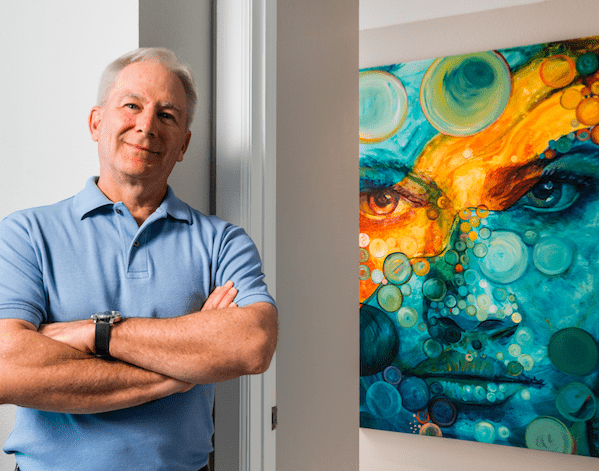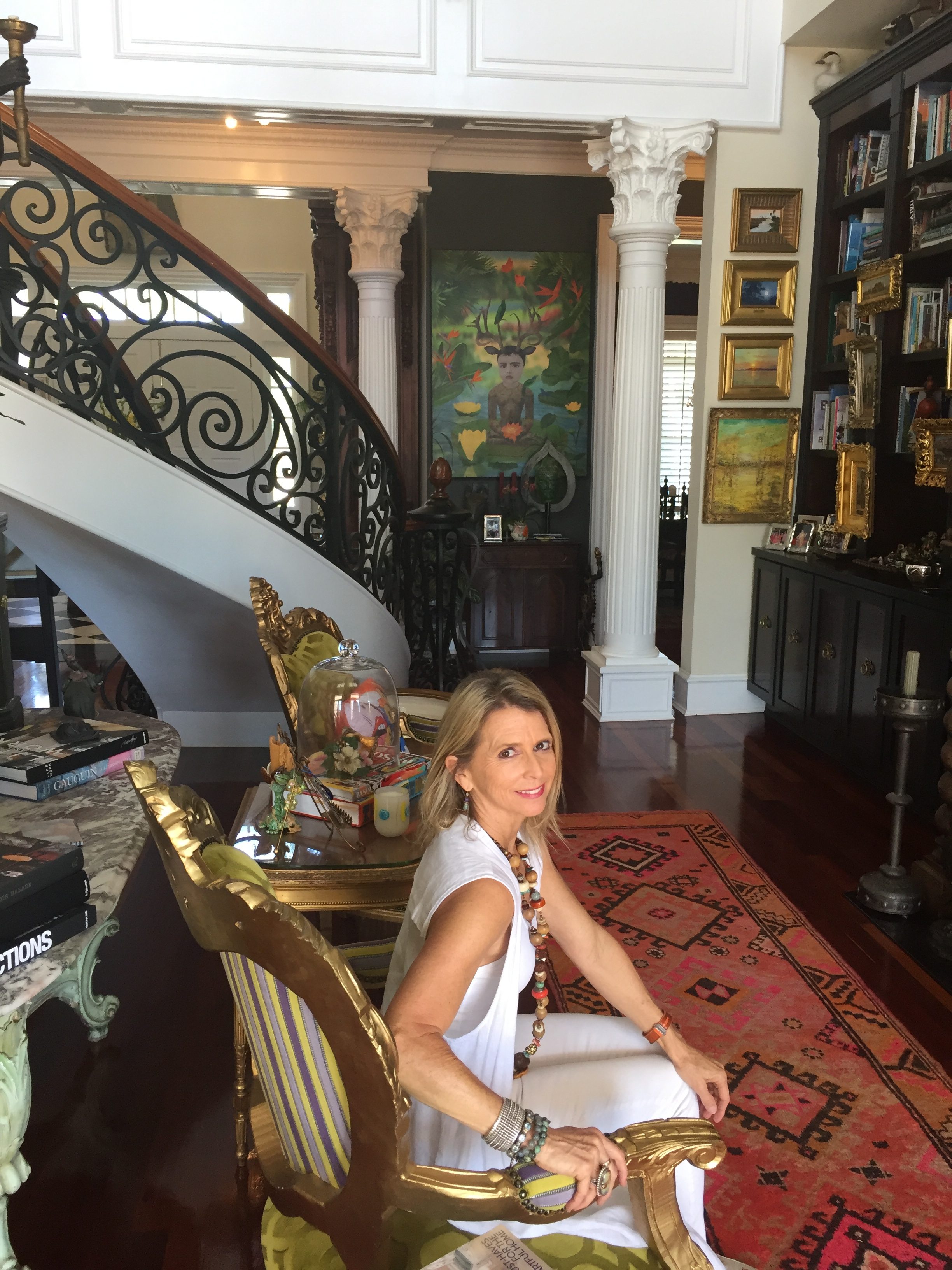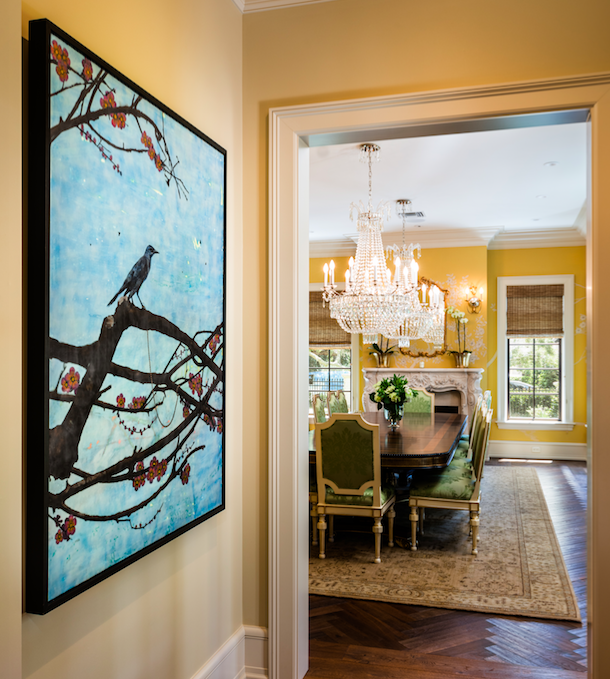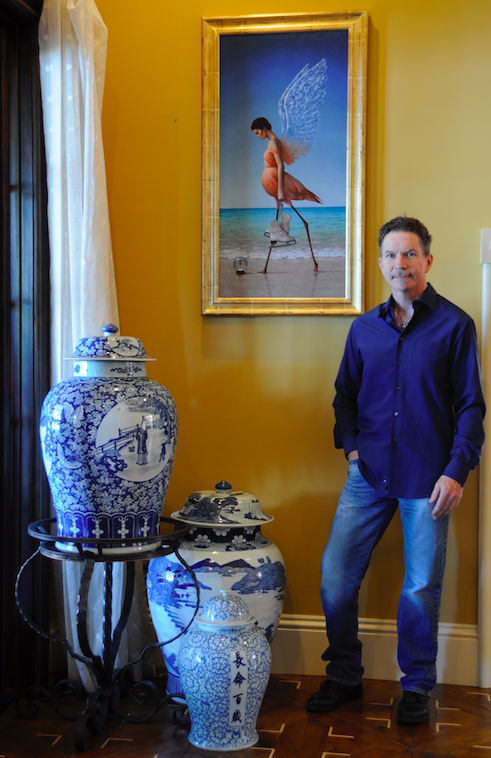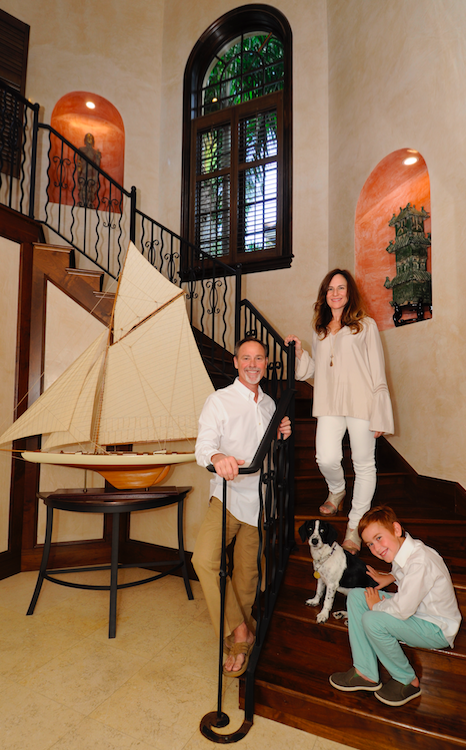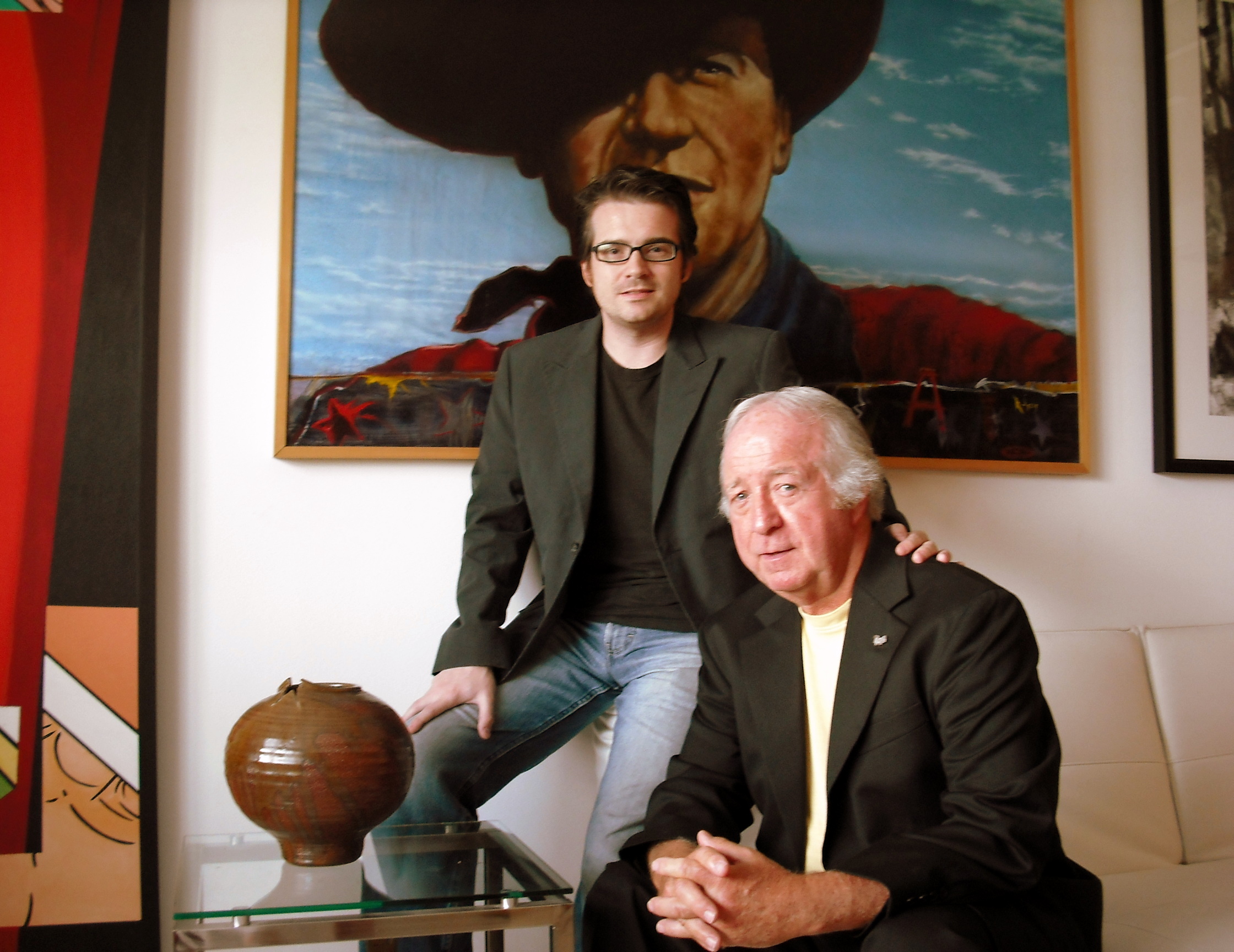“You look at every painting and you say, ‘Oh, wow!’”
Bob Brvenik loves his art collection so much that when he returns to his Sand Key condo after being away for a while, it’s like a family reunion.
“You walk in and you look at every painting and you say, ‘Oh, wow!’” says Brvenik.
A 63-year-old retired real estate exec who didn’t know he was interested in contemporary art until he met artists’ agent Alison West Brown, he built his collection according to a rule I heard from everyone I spoke with for this story:
Don’t buy a work of art because it matches the couch, or because you think it’ll make good money on resale, or because you want to impress your friends.
Buy what you love.
Bob Brvenik: “Around every corner there’s a surprise.”
Three years ago, Brvenik (pronounced Brenik) bought his condo and enlisted interior designer Suzan Decker Ross to help with a radical rebuild. “I was always a traditionalist,” he says, but the look he was going for now was anything but traditional. “I guess I’m discovering new things about myself ”—including, once Decker Ross connected him with Brown, new things about his taste in art.
“Bob came in through my front door,” remembers Brown, “and he started turning around in circles.”
The view from the doorway of her imposing Clearwater home is a testament to Brown’s passion for collecting. The walls, the bookshelves, the tables are stacked and double-stacked with art of all kinds, from solemn to wacky, traditional to pop.
“I was overwhelmed,” he recalls. “Five minutes into it I was ready to leave.”
But then Brown showed him her gallery—a smaller space over her garage in which she shows works by the artists whom she represents.
“I didn’t know I liked this kind of art,” she recalls him saying. He’d thought he was going to fill his condo with faux Impressionists, but she had other ideas—like a big abstract called “Thought Bubbles” by St Petersburg-based artist Kate Cummins, with a central block of golden, glowing color.
“At first I thought it was like a New York City taxi coming to run me over,” says Brvenik. “Then the moment we put it up, it was like, wow.”
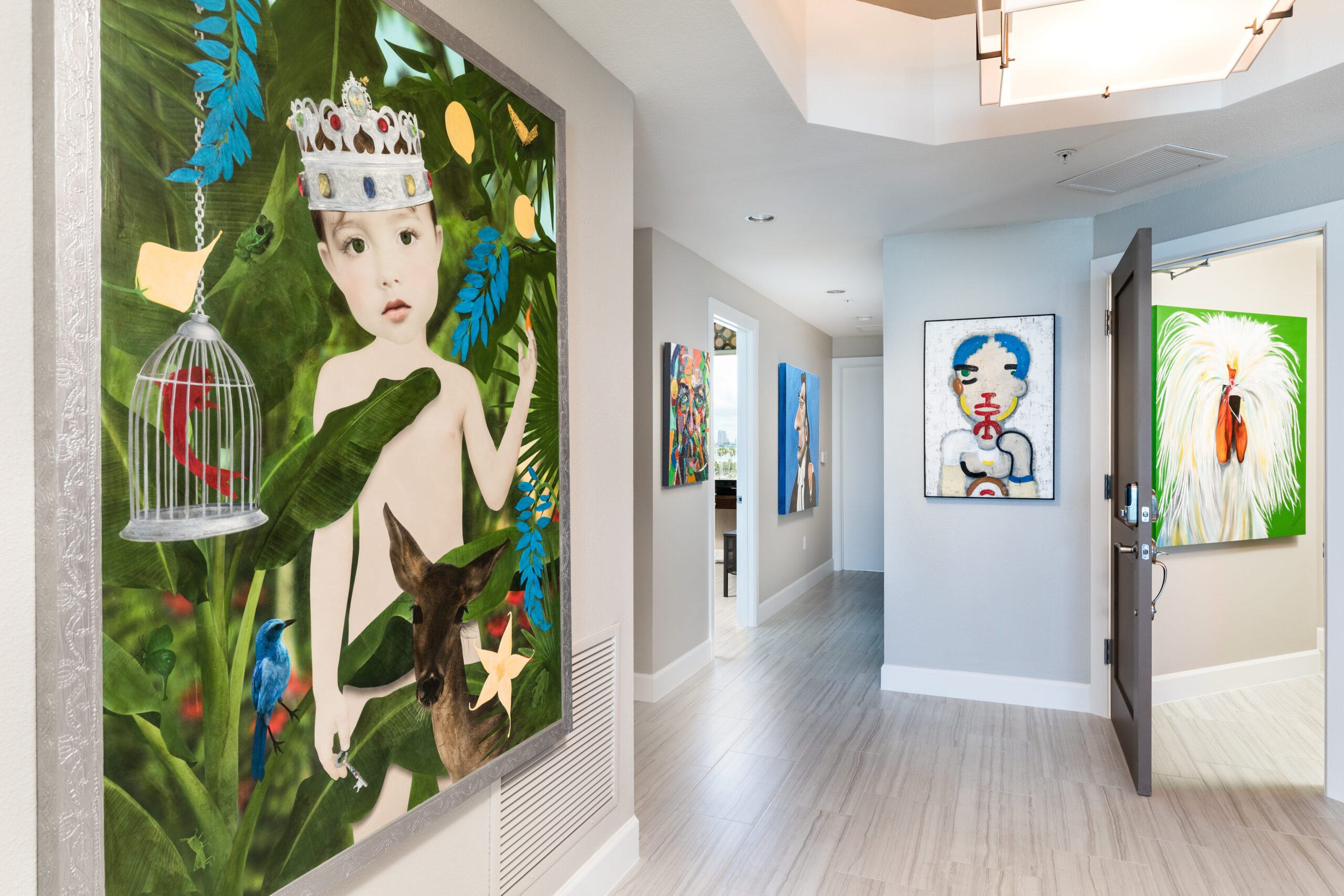
Brown can sympathize with his evolving tastes. “I went from a lot of very traditional Southern art to being in love with pop art, colorful art, art that tells a story and even art that doesn’t make sense.”
And art with a sense of humor, a quality Brvenik looks for, too—hence their mutual fondness for painter Marc Levasseur, whose flamboyant rooster, “Big Papa,” greets Brvenik’s visitors as they get off the elevator, and whose Andy Warhol sendup, “Be Yourself or Go Bananas,” triggers surprised laughter from visitors in the guest bathroom.
The placement of both paintings reflects an aesthetic Brvenik attributes to the Florida hotel designer Addison Mizner: “Around every corner there’s a surprise.” It’s in evidence throughout the apartment, most stunningly with the way he and Brown have hung Carrie Jadus’s gorgeous “Tranzlucid Intentions,” an oil portrait in near-psychedelic colors of a woman’s face. It takes up almost an entire wall, but you only come upon it when you look toward a bedroom corridor off the living room—and then, well, wow.
Alison West Brown: “I will only try to sell something I am passionate about.”
“I will only work with and try to sell something that I am passionate about and have in my own home,” says Brown.
So it’s no surprise that, when we visit another of her clients, a family living in a sprawling mansion in Belleair, their collection includes some of the same artists as Brvenik’s.
The owners planned for art in advance. Working with architectural firm FleischmanGarcia three years ago, they asked that the home include a gallery. The result: a beautifully lit corridor that serves as a showcase for works by Cummins, Joan Duff Bohrer and other artists represented by Brown. Art is integrated into their three young children’s lives, too.
In an upstairs family room, the TV shares wall space with a Marcel Kahhak painting of a skier (reflecting a family interest) and a few steps away near the game table Greg West’s portrait of a man nose-to-nose with a rhino is a surefire laugh-getter. (Its title: “Ooh, You Need a Breath Mint.”)
The furnishings came primarily from Design Interiors in Tampa, but just about all the art came from Brown — so the juxtapositions are pleasing and often surprising. The formal dining room evokes the home’s French Renaissance architec- tural style with its ornate fireplace and generously propor- tioned windows looking out on landscaped greenery. In the hallway as one enters the room, Jeff League’s “Grackle”—a photo/encaustic of a lone bird on sparse branches—echoes the natural beauty outside but also offers a bracing contrast with the interior’s opulence.
“Art just makes everything pop,” says the homeowner, and her home is a marvelous case in point.
Liz Dimmitt: “I have these little love affairs with the artists I collect.”
Liz Dimmitt and Piers Davies know all about unexpected juxtapositions. Their marriage is a partnership of two internationally known art consultants whose spheres of interest are literally centuries apart.
Dimmitt, who ran NYC’s prestigious Lehman Maupin Gallery before opening her consultancy, advises private and corporate clients interested in contemporary art. A passionate collector herself, she’s particularly interested in younger, emerging artists.
Davies is an expert on artists of a different vintage—the Old Masters. His company, NYC-based Piers Davies Fine Art, helps individuals and institutions add to their collections and assess the value of works they already possess.
Dimmitt describes what she does as “sort of a dating process. You get to know collectors and their tastes and get them out to see shows.”
She also provides access. “A lot of times if you’re working with an art consultant, you’re in the know about what’s avail- able. Art galleries trust me to place artwork into collections that are exciting and good.”
And the bonus of collecting contemporary art, particularly the emerging talents whom she likes to follow, is that you get to know the artists as well as their art.
“I have these little love affairs with the artists I collect. They’re people I want to go to dinner with, have conversations with.”
Piers Davies: “It’s all about the story.”
Which is not something her husband can do with his artists, being that they’re, well, dead. And in some cases they don’t even have names. But the anonymity factor is part of why Davies’s field can be so much fun.
“With Old Masters,” he says, “if you’re interested in detective work and discovery—the excitement of the historical chase—there’s much to be found.”
Davies himself chased down a “suspect.” A family in New Jersey hired him to track down the provenance of a portrait they’d owned since the 1930s — a painting of George Washington when he was a Revolutionary War general, dashed off on the battlefield by the young Boston artist Joseph Wright during a pause in fighting. Experts had dismissed it as a 19th-century copy, “but I had a gut feeling it had a chance,” he says—and ordered a process akin to an investigation on CSI. After months of x-rays, infrared, and pigment analysis, it became clear it was the real thing. (The painting is now in the collection at Mount Vernon.)
He and his wife both emphasize that you don’t have to spend a small fortune to start collecting in their fields.
It’s possible to collect Old Master drawings for under $5,000, says Davies. And there’s contemporary art “at every price point,” says Dimmitt, “from local art fairs for $10-$50 to hundreds of millions of dollars. The joy from that object is probably the same.”
And if Old Master collectors don’t get the pleasure of, say, schmoozing with Leonardo da Vinci at an opening reception (“Love what you did with the ceiling, Leo!”), they get something just as entertaining, if not more, says Davies.
“It’s all about the story. They like the narrative.” As a Brit (his wife is a native Floridian), he says he’s surprised “by how little history is taught in American schools.” That may be why people are drawn to collecting Old Masters, he suspects. “All of the human interest stories—power, jealousy, money—are relevant today.”
Matthew Mosk & Claudia Larrain: “Share it with others.”
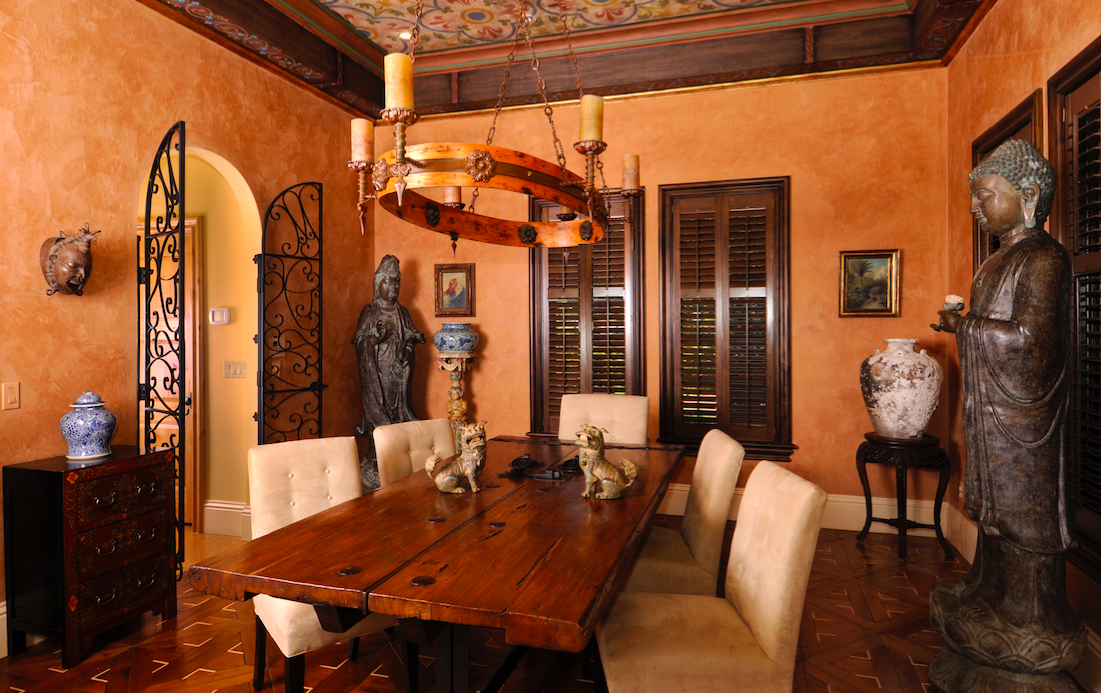
Every object tells a story in the Claudia Larrain/Matthew Mosk household, which made it the ideal location for the kickoff of “Home Is Where the Art Is” on September 15—a tour of private art collections in St. Pete’s Old Northeast neighborhood to raise funds for Florida CraftArt and The Studio@620.
Each residence was chosen to show the myriad ways in which art can enrich our lives, echoing the theme of the current CraftArt show, “At Home with Craft.” (The tour is sold out, but the gallery show continues through Oct. 27.)
You might assume from looking at the family’s Spanish Revival home on Coffee Pot Boulevard that’s it been there for decades. But no—it was built in 2008, designed by architect Bertram Aubrey Thomas in a style meant to suggest an earlier time, an impression augmented by the Tampa artist Ron Francis, who gave the interior walls and ceilings a convincing patina of age.
The real history lies in the couple’s polyglot collection of ancient artifacts and family heirlooms, mixed with work by contemporary artists. Fortunately for visitors, both Mosk and Larrain are delighted to talk about all of it.
“I think that when you have art, it’s your responsibility to share it with others,” says Mosk, 50, an industrial real estate developer. Sometimes the tales of how they obtained an object rival the history of the object itself—like the pre-Columbian musical instrument in the shape of an owl that Mosk bought at a parking garage security booth in Costa Rica. Or the urn discovered by divers in the Philippines in the remains of a Chinese junk shipwrecked in the 1600s.
Their collection also reflects Larrain’s family ties in Chile, where her ancestors included an expatriate Englishman named Bunster and a great grandfather who was a consul to Spain. His uniform is hanging on the second-floor landing, as are documentary photographs by 1960s Chilean photographer Sergio Larrain—no relation, she thinks, despite the surname, and despite the fact that she’s a fine art photographer herself.
Larrain, 47, has a Ph.D. in clinical psychology (“I don’t practice it anymore but I use it every day”), and tends to look at “the emotional aspects” when considering artworks. Her favorite contemporary piece is “The Ice Wings” by the St. Petersburg artist Steven Kenny, which hangs in her living room above a pair of blue and white Ming dynasty urns. It’s an exquisite portrait of a woman with crystalline wings and flamingo legs, standing on a beach and carrying a pair of ice skates as she looks down at a snow globe on the sand.
“I feel she’s very sad and she’s missing her craft, which is ice skating,” says Larrain. “It’s the summertime, her wings are melting, so she’s looking at this globe of an ice skater thinking, ‘Oh, I want to be there.’ There’s sadness but there’s hope.”
But her niece, a conservationist, had voiced an entirely different interpretation, says Larrain. “She said, ‘She’s losing her wings in summertime because of global warming!’”
Mosk suggested another reason why his wife was drawn to the picture. “What she’s not saying is that she connects with it because she used to be a ballerina.”
So many interpretations, so many stories. But that’s part of why a home filled with art is so nourishing. They become part of your family lore.
And every member of the family can take part. Sebastian, the couple’s sunny-natured 7-year old, will eagerly chime in to tell you how the family procured the big sailboat replica in the foyer. (He’s also been known to shake hands with the imposing Buddha in the dining room.) Do get Mosk to explain about the Egyptian seismograph in the kitchen. And ask Larrain to show you the piece by an underwater photographer named Gugg.
Connection is at the heart of collecting. The artists, the collectors, the advisors—they do it for the joy.
A class in collecting
If you’d like to start an art collection but fear you don’t know enough about art, Ken Rollins is here to help. Rollins is a vastly experienced museum professional (he’s been executive director of four local museums) whose firm, Rollins Fine Art, connects artists from all over the U.S.
with individual and corporate clients. He’s going to be sharing his expertise in two classes this fall at the ARTicles Gallery in St. Pete (mid-November) and the Dunedin Fine Art Center (late October). Both are entitled “Building a Collection” and both are directed at young professionals (or the young at heart). “I’m hoping to increase people’s comfort level with aesthetic decisions,” says Rollins. “Everyone makes them every day—they just don’t know they’re doing it.”
For details, contact Leslie Curran at articlesstpete.com and Sara DeLorenzo at sara@dfac.org.

